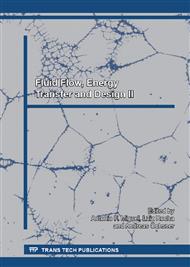[1]
N. Zobeiry: Viscoelastic constitutive models for evaluation of residual stresses in thermoset composites during cure, University of British Columbia, (2006).
Google Scholar
[2]
G. Fernlund: Spring-in of angled sandwich panels, Compos. Sci. Technol., vol. 65, no. 2, pp.317-323, (2005).
DOI: 10.1016/j.compscitech.2004.08.001
Google Scholar
[3]
H. T. Hahn and N. J. Pagano : Curing Stresses in Composite Laminates, J. Compos. Mater., vol. 9, no. 1, pp.91-106, (1975).
Google Scholar
[4]
L. P. Kollar: Approximate Analysis of the Temperature Induced Stresses and Deformations of Composite Shells, J. Compos. Mater., no. 5, pp.392-414 (1994).
Google Scholar
[5]
D. W. Radford and R. J. Diefendorf: Shape Instabilities in Composites Resulting from Laminate Anisotropy, J. Reinf. Plast. Compos. , vol. 12 , no. 1 , pp.58-75, (1993).
DOI: 10.1177/073168449301200104
Google Scholar
[6]
K. J. Yoon and J. -S. Kim: Effect of Thermal Deformation and Chemical Shrinkage on the Process Induced Distortion of Carbon/Epoxy Curved Laminates, J. Compos. Mater., vol. 35, no. 3, pp.253-263, (2001).
DOI: 10.1177/002199801772662244
Google Scholar
[7]
E. Kappel: Process Distortions in Composite Manufacturing - From an Experimental Characterization to a Prediction Approach for the Global Scale, Otto-von-Guericke University Magdeburg, (2013).
Google Scholar
[8]
A. A. Johnston: An integrated model of the development of process-induced deformation in autoclave processing of composite structures, University of British Columbia (1997), PhD.
Google Scholar
[9]
G. Fernlund, N. Rahman, R. Courdji, M. Bresslauer, A. Poursartip, K. Willden, and K. Nelson: Experimental and numerical study of the effect of cure cycle, tool surface, geometry, and lay-up on the dimensional fidelity of autoclave-processed composite parts, Compos. Part A Appl. Sci. Manuf., vol. 33, no. 3, pp.341-351, (2002).
DOI: 10.1016/s1359-835x(01)00123-3
Google Scholar
[10]
G. Fernlund, A. Osooly, A. Poursartip, R. Vaziri, R. Courdji, K. Nelson, P. George, L. Hendrickson, and J. Griffith: Finite element based prediction of process-induced deformation of autoclaved composite structures using 2D process analysis and 3D structural analysis, Compos. Struct., vol. 62, no. 2, pp.223-234 (2003).
DOI: 10.1016/s0263-8223(03)00117-x
Google Scholar
[11]
T. a. Bogetti and J. W. Gillespie: Process-Induced Stress and Deformation in Thick-Section Thermoset Composite Laminates, J. Compos. Mater., vol. 26, no. 5, pp.626-660, (1992).
DOI: 10.1177/002199839202600502
Google Scholar
[12]
J. M. Svanberg: Predictions of Manufacturing Induced Shape Distortions - High Perfomance Thermoset Composites, Lulea University of Technology (2002), PhD.
Google Scholar
[13]
P. Prasatya, G. B. McKenna, and S. L. Simon: A Viscoelastic Model for Predicting Isotropic Residual Stresses in Thermosetting Materials: Effects of Processing Parameters, J. Compos. Mater., vol. 35, no. 10, pp.826-848, (2001).
DOI: 10.1177/002199801772662424
Google Scholar
[14]
Y. K. Kim and S. R. White: Process-Induced Stress Relaxation Analysis of AS4/3501-6 Laminate, J. Reinf. Plast. Compos., vol. 16, no. 1, pp.2-16 (1997).
DOI: 10.1177/073168449701600102
Google Scholar
[15]
R. Hein, P. Steinle, T. Wille: Pseudo-Viscoelastic vs. Viscoelasic: Evaluation of Two Material Models for Curing Simulation of CFRP, Conference Proceedings, NAFEMS, Bamberg, Germany (2014).
Google Scholar
[16]
C. Brauner, Analysis of process-induced distortions and residual stresses of composite structures, Faserinstitut Bremen (2013), PhD.
Google Scholar
[17]
M. V. Zocher: A thermoviscoelastic finite element formulation for the analysis of composites, Texas A& M University (1995), PhD.
Google Scholar
[18]
H. Poon and M. F. Ahmad: A material point time integration procedure for anisotropic, thermo rheologically simple, viscoelastic solids, Comput. Mech., vol. 21, no. 3, pp.236-242 (1998).
DOI: 10.1007/s004660050298
Google Scholar
[19]
L. K. Jain and Y. -W. Mai: Stresses and Deformations Induced during Manufacturing. Part I: Theoretical Analysis of Composite Cylinders and Shells, J. Compos. Mater., vol. 31, no. 7, pp.672-695, (1997).
DOI: 10.1177/002199839703100703
Google Scholar
[20]
H. W. Wiersma, L. J. B. Peeters, and R. Akkerman: Prediction of springforward in continuousfibre/polymer L-shaped parts, Compos. Part A Appl. Sci. Manuf., vol. 29, no. 11, pp.1333-1342, (1998).
DOI: 10.1016/s1359-835x(98)00062-1
Google Scholar
[21]
N. I. Karkanas and I. K. Partridge: Cure Modeling and Monitoring of Epoxy/Amine Resin Systems. I. Cure Kinetics Modeling, J. Appl. Polym. Sci., vol. 77, no. 7, pp.1419-1431. (2000).
DOI: 10.1002/1097-4628(20000815)77:7<1419::aid-app3>3.0.co;2-n
Google Scholar
[22]
S. Freund: Entwicklung eines Programms zur robusten Bestimmung der reaktionskinetischen Modellparameter für die Aushärtesimulation von Epoxidharzen., German Aerospace Center (DLR), Internal Report (2010).
Google Scholar
[23]
J. P. Pascault and R. J. J. Williams: Glass Transition Temperature Versus Conversion Relationships For Thermosetting Polymers, vol. 28, p.8595 (1990).
Google Scholar
[24]
J. D. Ferry: Viscoelastic Properties of Polymers, 2nd Edition, New York: John Wiley & Sons (1980).
Google Scholar
[25]
G. C. Papanicolaou and S. P. Zaoutsos: Viscoelastic constitutive modeling of creep and stress relaxation in polymers and polymer matrix composites, Woodhead Publishing Series in Composites Science and Engineering, R. M. B. T. -C. and F. in P. M. C. Guedes, Ed. Woodhead Publishing, p.347, (2011).
DOI: 10.1533/9780857090430.1.3
Google Scholar
[26]
D. Kroshko: OpenOpt, [Online], Available: http: /openopt. org.
Google Scholar
[27]
International Standard: Plastics-Differnetial Scanning calorimetriy (DSC), Part 2: Determination of glass transition temperature (1999).
Google Scholar
[28]
M. Herdy: ViscoData & ViscoShift, Avaiable: http: /www. viscodata. de, (2003).
Google Scholar
[29]
C. C. Chamis: Simplified composite micromechanics equations for hygral, thermal and mechanical properties, SAMP Q., vol. NASA-TM-83, COMPOSITE MATERIALS, p.19 (1987).
Google Scholar
[30]
Hutchinson S. A.: http: /www. hutchinsonworldwide. com.
Google Scholar
[31]
H. Schürmann: Konstruieren mit Faser-Kunststoff-Verbunden, Berlin/Heidelberg, SpringerVerlag (2005).
DOI: 10.1007/b137636
Google Scholar
[32]
R. F. GmbH: R& G Handbook Composite Materials, http: /www. r-g. de (2014).
Google Scholar
[33]
A. S. Ulrich Fischer, Roland Gomeringer, Max Heinzler, Roland Kilgus, Friedrich Näher, Stefan Oesterle, Heinz Paetzold: Tabellenbuch Metall mit Formelsammlung, Europa-Lehrmittel (2011).
Google Scholar
[34]
V. Kaushik and J. Raghavan: Experimental study of tool-part interaction during autoclave processing of thermoset polymer composite structures, Compos. Part A Appl. Sci. Manuf., vol. 41, no. 9, pp.1210-1218, (2010).
DOI: 10.1016/j.compositesa.2010.05.003
Google Scholar


